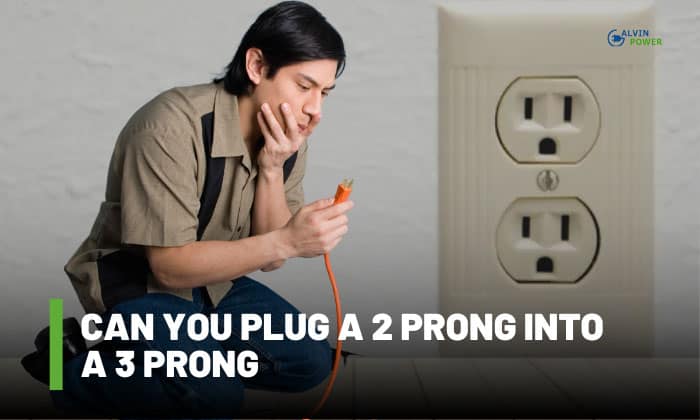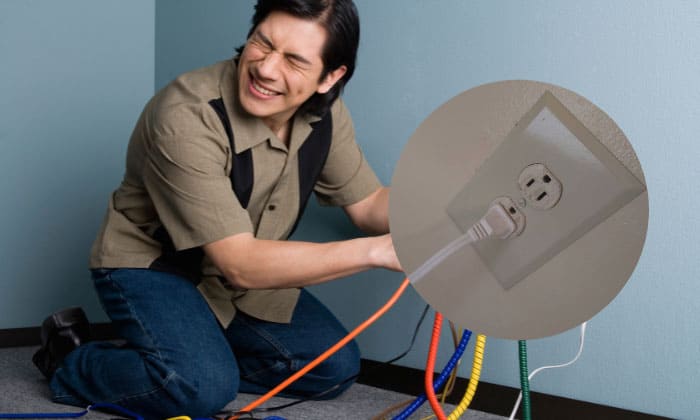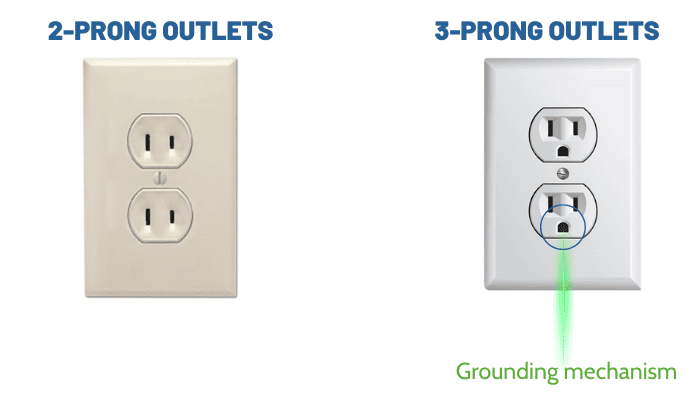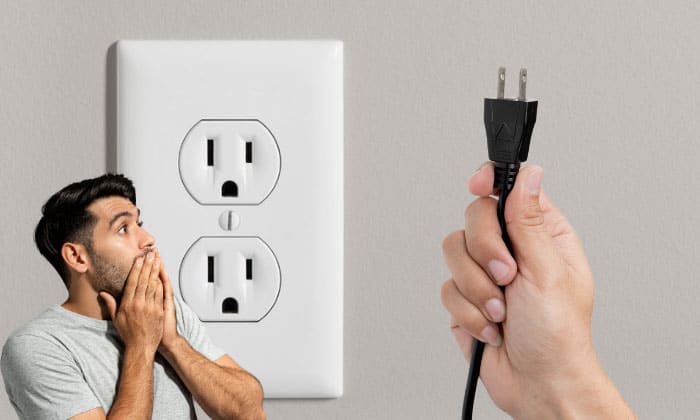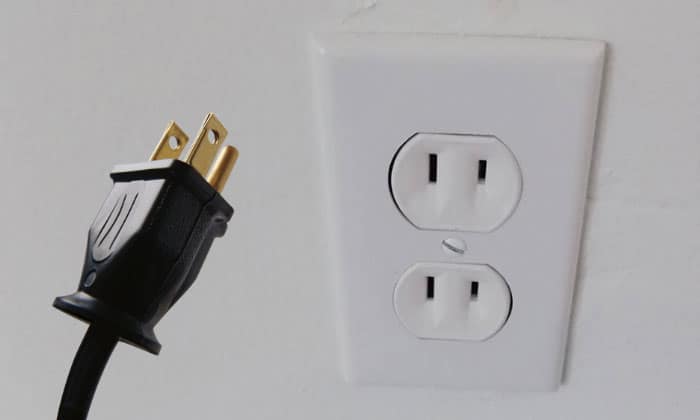A new appliance or electronic device can come with a 2-prong plug. Now, the question is, can you plug a 2-prong into a 3-prong outlet?
Yes, you can connect a 2-prong plug into a 3-prong outlet. But it’s generally not a safe option because of the absence of ground, increasing the risk of electrical shock or damage to the device.
Stick through this post until the end. That way, you can learn more about 2-prong and 3-prong connections, along with other relevant information.
Table of Contents
Is It Safe to Plug a 2-Prong Into a 3-Prong?
It’s not often ideal to plug a two-prong into a three-prong because of potentially dangerous situations that may arise.
Note that the third prong is generally a ground that should provide a path for an electrical current to discharge safely. As mentioned earlier, without ground, the connection may result in an electrical shock or irreparable harm to the device.
Difference Between 3-Prong Vs. 2-Prong Outlets
The main difference between 2-prong and 3-prong outlets is that the latter has a grounding mechanism. 2-prong outlets lack this feature, making them less safe than their 3-prong counterparts.
This grounding prong helps generate a path for an electrical current to return to the breaker box. Doing so aids in preventing harm to the circuit, electrical wiring, or connected electronic device.
Safety Concerns With Plugging a 2-prong Into a 3-Prong Outlet
Plugging a 2-prong plug into a 3-prong outlet raises various safety concerns. Although it may seem harmless, the absence of the third grounding prong can lead to serious consequences, particularly if the circuit or device malfunctions.
If an issue occurs with the current, its path may deviate from its intended path. This event may result in electrocution, irreparable damage to the device, or even a house fire. Avoid making this connection as much as possible to reduce these risks.
Still, plugging a 2-prong plug into a 3-prong outlet may not result in these serious consequences. But preventing these harmful instances from happening can also lead to peace of mind.
Solutions for Plugging a 2-Prong Device Into a 3-Prong Outlet
Use a grounding adapter to help prevent these issues from occurring. This small unit attaches to the plug, creating the grounding path despite the absence of the third prong on the 2-prong plug.
Other solutions you may consider to help ground a 2-prong cord are:
- Hire an electrician to convert the appliance’s cord or rewire the outlet
- Install a metal housing box for the outlet
- Install a GFCI at the outlet, and place a “No Equipment Ground” label on it
- Replace the standard circuit breaker with a GFCI model
Related:
FAQs
What Happens If You Plug a 3 Prong Into A 2 Prong?
First, plugging a 3-prong into a 2-prong requires an adapter. Otherwise, the 3-prong plug won’t fit into the 2-prong outlet. But using this connection isn’t safe, for the grounding prong won’t serve its purpose.
Are There Any Benefits When Plug 2-Prong Into a 3-Prong?
Plugging a 2-prong into a 3-prong typically doesn’t provide any benefits. Even when using an adapter, no connection is made to the grounding unit. As a result, it may even lead to a higher-than-normal risk of electrical issues occurring.
Can Using a 2-Prong Plug In a 3-Prong Outlet Damage My Electrical Devices?
Note that 2-prong plugs connected to 3-prong outlets connect their hot and cold wires to their respective prongs. The cold wire may provide some degree of grounding, but it’s not true ground.
So, using 2-prong electrical plugs in 3-prong outlets imposes the risk of damaging connected electrical devices. Plus, a person holding the wire may experience an electric shock during the malfunction.
Are There Any Alternatives to Using an Adapter for a 2-Prong Plug?
Aside from using an adapter, a 2-prong extension cord should work fine. But it’s still important to use the appropriate extension cord when powering devices.
However, a grounded extension cord may provide additional security to connected electrical devices. It’s because of the presence of the grounding prong on the cord that helps prevent issues like electrocution and fires.
Tips for Using Adapters And Power Strips Safely
Below are some of the do’s and don’ts you should follow when using adapters and power strips:
- Do only connect light-load appliances to adapters and power strips
- Do use power strips with internal circuit breakers
- Do use adapters, extension cords, and power strips sparingly
- Don’t daisy-chain adapters and power strips
- Don’t use power strips in moist locations, like bathrooms and kitchens
- Stop using an adapter or power strip if it feels hot
What Is A Cord Prong?
The prong in a cord is a pin supported by a casing or plastic support. It inserts into the holes of an outlet, establishing a circuit to help power connected electronic devices.
Are Two-Prong Plugs Safe?
2-prong plugs are considered outdated and provide more risks than 3-prong variants. The lack of grounding won’t safely transfer unstable current, resulting in unsafe incidents.
Is It Safe To Remove The Ground Prong?
Although you can remove the ground prong of a 3-prong plug, avoid doing it. It’s unsafe to cut the ground prong as it increases the risks of serious consequences from the absence of grounding.
If you have a 2-prong outlet, you may use a cheater plug. It’s a 3- or 2-prong adapter that can connect to non-grounded receptacles. Note that the grounding prong still won’t connect to the outlet, resulting in a loss of ground.
Is It Safe To Use A Light Socket Outlet?
A light socket receptacle doesn’t usually have ground, making them unsafe when electrical issues arise. However, users can rewire a light socket to add grounding to it. Here’s a quick rundown of the steps to complete this task:
- Disassemble the lighting fixture
- Cut the end of the 3-wire electrical cord
- Insert a new 3-wire plug with grounding to the fixture
- Strip the ends of the new wire and connect it to the fixture
- Attach and secure the wire to the fixture with an insulated material
- Reassemble the lighting fixture and check if it works properly
Note that some of the steps mentioned above may not be applicable to your specific lighting fixture. Also, request help from a certified and trustworthy electrician if you have trouble or aren’t confident in completing this task.
Does An Outdoor Extension Cord Have A Ground?
Outdoor extension cords generally have three prongs. That means that these strips usually have ground.
Aside from the three prongs, you can recognize an extension cord built for outdoor or heavy use when it has other features like:
- It has the letter “W” on the cord or packaging
- The color of the strip is bright orange or has a plastic or vinyl covering
- The existence of high amperage ratings
Conclusion
Now, you should know the answer to your initial question, “Can you plug a 2 prong into a 3 prong?” Remember, it’s not ideal to complete this connection because of known safety hazards.
Note that plugging a 2-prong plug into a 3-prong outlet may not lead to problems. But it may also cause anxiety, knowing that leaving this connection might still result in issues like electrocutions or even house fires.

I am Edwin Jones, in charge of designing content for Galvinpower. I aspire to use my experiences in marketing to create reliable and necessary information to help our readers. It has been fun to work with Andrew and apply his incredible knowledge to our content.

